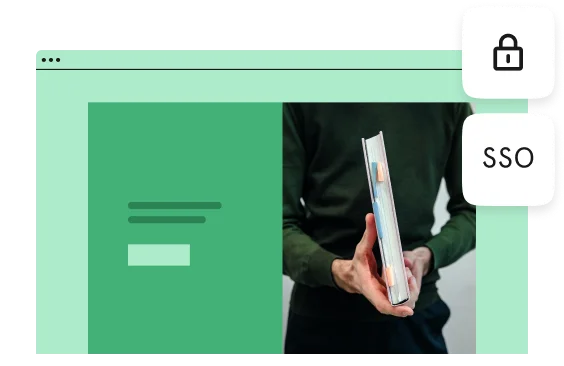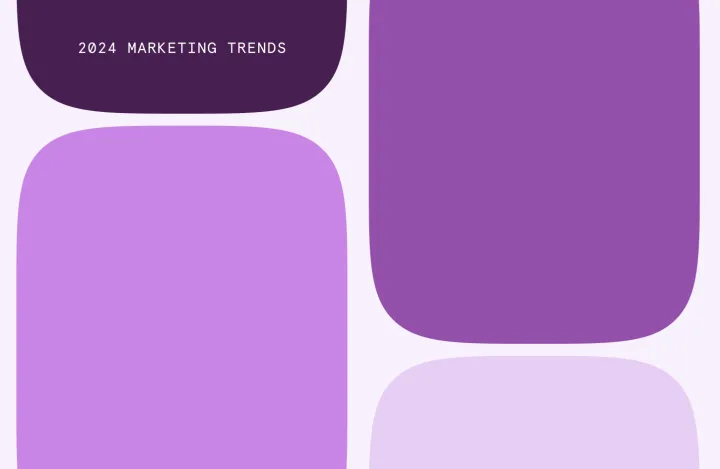Contents
01 The future of marketing lies in artificial intelligence (AI) 02 Augmented and virtual reality (AR/VR) will make a comeback03 Marketers will emphasize their brand’s values04 Hyper-personalization will remain top of mind05 Short-form video content will reign supreme06 Nano and micro-influencers will replace celebs07 What’s next?The world of marketing and advertising is ever-evolving—how can anyone stay on top of the hottest trends? We get it. On top of tracking metrics, strategizing your next campaign, and A/B testing new marketing initiatives, you’ve got to keep up with marketing and advertising trends. We’re breaking down the top six trends to expect in 2024, so you don’t have to. Keep reading to see the latest innovations in marketing.
1. The future of marketing lies in artificial intelligence (AI)
Since its launch in November of 2022, ChatGPT has made waves across every industry, but perhaps none more so than the marketing world. From chatbots that create a better customer experience to automations that streamline workflows, AI has very quickly become a mainstay in marketing.
While everyone is still trying to figure out how to get the highest return on investment (ROI) with AI, we see marketers leveraging it in a few ways.
Latest posts on Opinions & Expertise
Content creation
A HubSpot survey revealed that nearly half of marketers reported using AI for content creation—blogs, social media captions, website copy. And 88% plan to invest the same amount or more into AI.
Marketers are rethinking how they use AI to create content, especially after Google started cracking down on AI-generated content that didn't align with its people-first, EEAT guidelines. We expect marketing teams to continue using AI for content creation with guardrails and substantial edits that prioritize quality over quantity.
Process optimization
One of the most compelling cases for AI is its ability to make processes more efficient, so marketers can focus on higher-priority tasks. Marketers will continue to view AI as a powerful assistant, leveraging it even more this year, for things like:
Analyzing customer data to identify commonalities, like pain points and preferences
Predicting customer behavior based on data analysis
Segmenting customers for more effective marketing (personalization)
Prioritizing the customer experience through real-time chatbots
Automating tedious or mundane tasks like posting to social, lead generation, or sending emails
2. Augmented and virtual reality (AR/VR) will make a comeback
Remember those weird-looking goggles that the gaming industry and Meta popularized almost a decade ago? Well, they're back... and savvy brands are leveraging AR and VR to create truly immersive experiences, from fashion shows to visualizing how furniture will look in your home (we're looking at you, Ikea).
HubSpot found that 84% of marketers plan to invest in AR and VR in 2024, indicating a potential comeback. AR and VR can create unforgettable brand experiences, whether it's an interactive product demo or a virtual showroom. Some of the world's leading brands are already using AR and VR, like:
American Express. They hosted a virtual “You vs. Sharapova" event using VR where people played a virtual tennis match against Maria Sharapova.
Pokémon Go. Circle K and Pokémon Go parent company Niantic partnered to create an interactive AR experience, driving players to grab a coffee at Circle K.
With hardware becoming more accessible, expect a surge in AR and VR brand experiences.
3. Marketers will emphasize their brand’s values
Corporate social responsibility is no longer a nice-to-have—consumers demand it from brands. Harris Poll research shows that most shoppers, 82%, want a brand's values to align with theirs. When values didn't align, 75% of shoppers surveyed said they parted ways with a brand.
One of the more important values to consumers? Sustainability. Fifty-two percent said they want to support sustainable brands, with 55% willing to pay more for sustainable products. To appeal to their customers, brands will highlight their values. And according to HubSpot, 45% will increase their investments in creating content to do so.
4. Hyper-personalization will remain top of mind
Whether it's from a form, survey, or email, marketers can collect vast amounts of data on their customers to create even more personalized experiences. And customers expect it.
A Segment study found that more than 55% of consumers will be repeat buyers after a personalized experience. The same study found that nearly 70% of businesses are increasing their investment in personalization.
Personalization starts with data, and if you can get it straight from your customers, you can create even more tailored content, marketing, and experiences. And with AI making analyzing data and segmenting faster than ever, marketers will continue to pour into creating hyper-personalized campaigns.
5. Short-form video content will reign supreme
Forty-seven seconds. Just a few years ago, attention spans were about 75 seconds, but now? "Now we find people can only pay attention to one screen for an average of 47 seconds,” says Dr. Gloria Mark, a professor of informatics at the University of California, Irvine.
Thanks to shortened attention spans and the rise of TikTok and other short-form video platforms, marketers will shift content toward shorter videos, like Instagram Reels, TikToks, and YouTube Shorts. They'll also focus on user-generated content (UGC), which is typically short in nature, free (with permission), and more authentic than perfectly polished brand content.
Videos under 60 seconds have an average 50% engagement rate. That rate drops to 17% with videos over 60 minutes.
6. Nano and micro-influencers will replace celebs
The Kardashians might have their name all over everything, but marketers in 2024 will move away from mainstream celebrities and toward nano and micro-influencers. Here's why:
Marketers have seen more success with influencers who have between 10k and 100k followers than with celebrities
Nearly 50% of marketers saw the most success with micro-influencers
Twenty-five percent of social media users surveyed by HubSpot bought something based on an influencer's recommendation
But nano and micro-influencers are also more affordable, with some willing to take free products as payment. And they have the highest engagement rates of all influencers, making a micro-influencer collaboration an easy decision.
What’s next?
2024 has become the year of AI, and we can't wait to explore it further (we're already using it to help you create forms). We don't know what's on the horizon, but we imagine it involves taking AI to the next level—whatever that looks like.
What do you think is the next big thing in marketing? Not sure? Subscribe to Informed—a monthly newsletter where we keep you up-to-date on industry trends, related opinions, tips and tricks, and other news.








